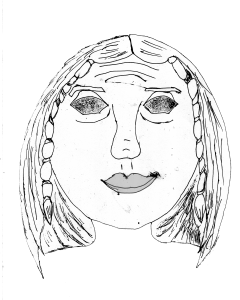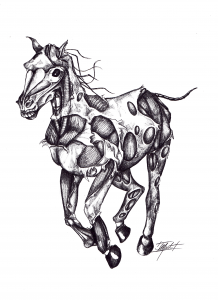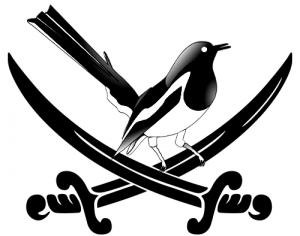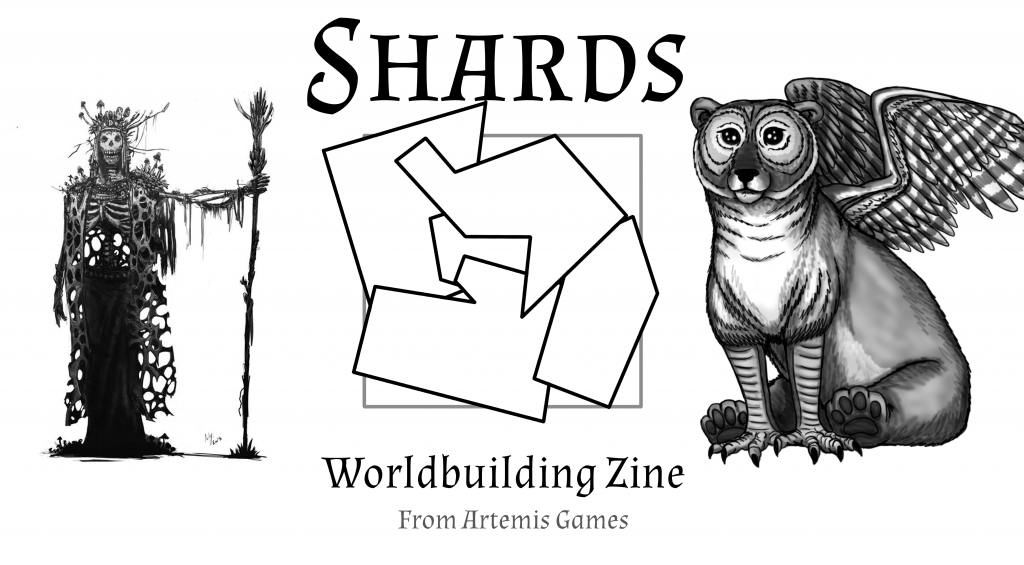




Not much to say this week, so have some art – and see if you can guess what we’ll be writing about 🙂





Not much to say this week, so have some art – and see if you can guess what we’ll be writing about 🙂
Welcome to the second monthly playtest report. Due to the levels of concentration we’ve been putting into Shards, and its kickstarter, we didn’t do much playtesting of our own games. Instead at the monthly Playtest Northwest meet I was playtesting an in-development computer game.
The game, created by Luke Perkins, is as yet untitled. So, for the purposes of simplicity I’ll call it LupeLang.
In LupeLang you play a scientist who has just been cryogenically frozen until the 35th century – at which time she is aware there is some sort of time anomaly, having received a message sent back through time. Unfortunately the message was written in a language unknown in the present day, and thus her assignment is to learn the future language and then send a translated message through the anomaly; and return through it herself if possible.
You awaken in a museum that has been laid out with exhibits of images from the 20th century and earlier, each of which is marked with a description in the future language – a form of pictographic representation. For instance: △ might mean “mountain”, and thereby also “stone” and “huge”, while ∪ means “artificial container” including buildings as well as pots.
As the game progresses you learn more about the language and solve puzzles involving locked doors that can only be opened by placing the correct symbols beneath a picture.
There were various issues with the control set up which I won’t go into here because I’m not massively interested in that side of video game design, but we also spent a lot of time discussing the worldbuilding aspects of the game.
In essence with a game with such a strange setup (you’re in a museum where every door is locked by code-locks with the password being pictured directly above them) you have two options:
Fortunately that sort of worldbuilding is exactly what we do at Artemis Games, so I was well set up to help with it. Ultimately we discussed it, and came up with a potentially quite compelling explanation; but one that Luke wants to keep as a slow-release mystery for the first stages of LupeLang. Still, all told while we weren’t playtesting anything of our own it was definitely a productive event.
Be Well
-Ste
The Shards: Worldbuilding Zine kickstarter is ending today, and while it’s far from the greatest success we’ve ever had, at 300% funded its undeniably successful.
So, what comes next?
Well, over the next six months there’s the fulfilment – every month we’ll be writing 44-48 pages of content for the zine, and keeping that exciting and informative is going to be a big job. But that’s not all we’re going to be doing.
Our current plans for the coming six months focus on the following:
We are – we’ve just increased the size of the Zine by 12% without adding a single extra page.
With our experience of printing on playing cards and small leaflets in our previous projects we’ve become well aware of the cost of wide borders, and the dangers of small ones – just how important it is to get them as small as possible and no smaller.
Shards is our first major case of printed long-form text, and we’ve therefore been playing with the borders for a while now, working out what size they can be – but we missed one major factor that more experienced book-printers would have spotted immediately: The three outside borders and the inside border should not be the same size. We’d been working with them equal, and that was costing us a lot of space as it means the borders had to be a whole 6mm (quarter of an inch) wider. That’s a 4% increase of the usable height, and 3% on the width.
But that’s only a 7% increase in area – so why am I saying 12%? That’s where the typesetting aspect comes in: words rolling over the end of the line, and paragraphs rolling over the end of a page, take up a surprising amount of space.
But Wait, There’s More: We’ve also tested decreasing the font size from its past 12pt to a smaller 11.5pt text, on the upper end of what paperback books use – it’s still thoroughly readable for even low-quality eyes, but it saves another 8%, letting us fit in even more content.
We knew from the start that we wanted the text bigger and clearer than on our past Concept Cards projects – their space requirements were far tighter – but we overshot what was necessary. Partly this is due to our first test print being done on a printer with a slight misalignment – the text blurred in a way that made it slightly harder to read at small sizes – which has now been corrected.
And Another Thing: We’ve settled on cream paper stock for the zine. We had been considering “Natural” paper, the kind that many older novels used – as it is nicely yellow, and a little more environmentally friendly. However we decided to do a test run on that paper type, and were reminded that the nice yellow tint of a good book takes about a year to really kick in – and we’re not going to be using tea to artificially age the Zine…
Let me leave you with a final thought: There’s one week left on this Kickstarter – so now’s the time to back before you miss out!
Be Well
-Ste
With the changing numbers of pages we’ve been doing a bit of shuffling around, but we’ve worked out which of the pieces we’ve got written will be going in the first issue – and which are getting pushed back to issues 2 and 3.
So here’s the contents section – page numbers are not included, as art and typesetting may shift some things; or a “People’s Hero” backer might increase the size of the Zine still further.
Editorial: Introducing the authors and the concept of the Zine
The Grand Labyrinth: The world’s largest maze, which hosts three or four exits: The three below and potentially the more mysterious Hero’s Gate, if combining with Issue #2s Labyrinth of Time
↳ The Wayfarer’s Gate: At the northwest of the maze is an exit best reached through days of painstaking progress
↳ The Warrior’s Gate: At the northeast of the maze is an exit which can only be reached by battling mechanical beasts
↳ The Adventurer’s Gate: At the center of the maze is the most challenging exit to reach, one that will take cunning, combat skill and endurance combined.
Bokort’s Bar: A future tavern with alien patrons and bartenders, alongside some technological gambling games.
↳ Staff: The bartenders, bouncer and croupier.
↳ Notable Patrons: Interesting people who might be found here reasonably often.
↳ Hooks: Example ways to weave the location into a story as well as a world.
The Great And The Wise: Neasa Aranrhod: A fey queen with an interest in answering questions “helpfully”.
↳ In Other Genres: Exploring how to alter Neasa to fit in worlds beyond traditional fantasy
Using the 5 Ws in Worldbuilding: An introductory article looking at how to dig deeper into an aspect of your world by asking the standard questions: “Who?”, “What?”, “Where?”, “When?”, “Why?” and the honorary sixth w “How?” – using one of our past creations to illustrate the method.
Magpie’s Nest: Stealing Thieves: Some things you can take from history, mythology, folklore and fiction to craft your worlds thieves, and their gods.
Letter Lich: In this issue, she answers a questioner asking how to incorporate Drow into a roleplaying campaign without causing trouble for an arachnophobic player.
Credits & Thanks: Art credits along with thanks to our biggest backers and supporters in this project.
As always your comments and input are welcome – although in this case rather than on facebook or twitter we’d most like to hear them over on the Kickstarter page
Launching in precisely 24 hours, 4pm on the 12th of February UK time, Shards will be us trialing a lot of new things – including an unusually philanthropic replacement for stretch goals. Take a look and let us know any questions you have.

We now have a date for Shards launch – the 12th of this month. It comes with a set, and appropriate, end date – the 4th of March “GM’s Day”.
We’ll be doing 6 issues over the next 6 months, each with three shards of setting – at least one being sci-fi and one being fantasy – a fourth article on worldbuilding, and a letters section where our resident agony aunt The Letter Lich can help you solve your worldbuilding and game-running problems.
Each issue is a minimum of 36 pages long, but there’s also going to be a high-roller backer level that allows the backer to fund 4 additional pages for every copy of the zine, for all six issues; because sometimes it feels good to give!
We’re currently finalising the writing and art for issue #1, and will be launching with those in the bag and at least half of May and June’s articles already written – insuring against any future schedule slips.
p.s. our regular weekly blog is here
Some of you have seen our other worldbuilding lines, through Kickstarter, Patreon, and DrivethruRPG, and are eagerly awaiting the next installment. Some of you have been shared this and don’t know what to make of us. Hi, we’re kinda story architects [Ste: I prefer story scaffolding specialists]. We help people tell stories.
So, I’ve run roleplay games for a couple of decades, – actually I prefer the term ‘storytelling games’ as it’s a better fit for the kind of games I run. Or possibly ‘movies in your head’ – I often use a vocabulary in common with film students – “In last weeks exciting episode….” Time for a Training Montage! And so on.
When we (my regular gaming group) sat down to talk shop, we realised we have all run up against a recurring problem. When I run a published module, chances are everyone in the game has read it, heard war stories about it, (and it turns out that the seeming safe path is illusion and there’s actually a plank down the middle of the room! Ha Ha!) or at the very least can look up a lot of the details on the Net. This makes for un-fun gameplay – the surprises aren’t, the doublecross fails when the party shoot the key NPC just to see what happens. The rest of the team have encountered similar with regards to published settings – it’s entirely possible that one of your players knows the setting better than you do.
The trick we all independently came up with is to use the same basic shape but give it a new twist. Perhaps the teacher is a nurse instead? Maybe the boss-fight-at-the-end is in a hospital instead of a back alley? The problem with this is is takes a lot more prep time than playing straight out of the book.
What we write is story elements and worldbuilding advice – so you can more easily mix it up a bit. Either plug our elements into existing settings as a quick twist – or tack a few together and make your own world.
Writers and storytellers too can make use of our pieces as prompts. Explore a character’s backstory; chronicle a location; begin on a planet. Almost everything we publish implies more is going on – we specifically don’t tie down elements like how magic works or what alien races exist. If you make use of a story-seed like this and write something, we’d love a copy. If you make a million, buy us a coffee or something.
Why ‘Shards’ ?
We wanted a word that implied disconnected pieces of a whole. Jigsaw didn’t work, as it implied more of a solid final setting. So we ran through a number of idea – fragments, modules, [scratched off pretty quickly due to the “adventure module” implication] capsules, chapters, even “world clay”.
As for why we ended up with Shards in particular? Blame the members of VAGUE – that’s the Manchester Metropolitan University Tabletop Gaming Society. We wandered along one week with a list of names, and asked anyone who would talk to us which ones they liked. I think marketers call it a focus group. We call it talking to your mates.
Why a Zine?
We’ve been kinda looking for a new way to do what we do best – make world pieces. We’ve made a lot of Concept Cards, and Jigsaw Fantasy was taking all our time for virtually no money. I’m sorry, terribly mercenary of us, but we got rent to find and bills to pay.
Honestly, we probably wouldn’t have thought of presenting in this way without KS doing their Zine Quest. But it does fit the criteria we’ve been looking for – not too expensive to print (we’re banking on you wanting to read it because it’s useful, not because it’s shiny), regular (see Douglas Adams’ wise words on deadlines) and managed – we can stop trying to be sales reps and get on with making new cool stuff for you to play with.
Kickstarter is a lot of things, from a pre-order platform to a place for helping small indie businesses get projects off the ground. Quickstarter is a little nod in the direction of the small and indie – so, us – by encouraging small, cheap, fast and simple kickstarters without all the studio-made videos and focus-tested page layouts that feature in the largest and most successful projects.
Another nod in that direction is Zine Quest spending February promoting RPG Zines, black-and-white, A5, fit-in-the-post magazines of RPG themed content. Again, right in our wheelhouse.
It’s been a year since we wound down Jigsaw Fantasy, planning to rebrand as Setting Shards and relaunch. So now is when we want to do so.
Put all those facts together and you get a crazy idea that just might work (and actually seems quite sensible after a month of working on it) – we’re taking the best bits of Setting Shards and distilling them down into a monthly Zine for GMs, Writers and other worldbuilding enthusiasts.
Each month will be a new issue containing four articles – three detailing Shards that can be dropped into fantasy and/or sci-fi settings and the fourth covering a more general concept without a specific answer where things like “Where do dragons nest, and why?” or “how do I come up with good names for characters and places, quickly?” can be explored
Next weeks blog will have more of the details – including the exact date for the launch. It will be early February, but how early? Well, that depends on when we have all the articles finished – as we experienced with Jigsaw Fantasy a monthly schedule brooks no delays, meaning we always need to maintain a buffer of completed pieces.
Words serve a purpose – they help us communicate ideas by transmitting thoughts from one person to another. In a way they are a kind of telepathy! Whether jeered over teamspeak, scrawled on a toilet wall, or merely thought really loudly, words can tell us something about your mum!
But words can be more than just the transmission of ideas – they can be fun. The ideas transmitted can inform, educate and entertain, there’s jokes, poems, stories, and best of all (in my opinion) role playing games (and yet I still don’t know whether that should be roleplaying role-playing or role playing. my spell checker thinks the latter, and that almost rhymes so I’ll go with that for now).
Choice of words matters. Different words have different connotations – Ali mentioned a couple of weeks ago about the difficulty in choosing the correct word for those who go to a spa, so I’ll not retread that ground here. I could have said “cover that again”, but instead chose to go with a metaphor because I found it more entertaining to do so, and one might literally tread ground at a spa. In that first paragraph I could have gone with “spoken, written or using sign language”, but I instead went for an old joke because it’s more entertaining and more arresting.
In the beginning language was entirely auditory – we spoke, we grunted, we howled (well, I did anyway). And the spoken language still has a special place. Some words are just fun to say, they’re make your mouth make interesting shapes, or your vocal cords produce unusual noises. Cassock, plinth, ullulate. Say all of these out loud slowly and recognise the weird things your mouth and voice are doing – the first starts and ends hard, but is soft in the middle, the second makes your tongue almost come out of your mouth, and the third, kind of goes everywhere. Even devoid of meaning these words can entertain – meaning is not necessary for communication as Noam Chomsky famously pointed out with the nonsense sentence “Colorless green ideas sleep furiously” (note the American spelling of colorless, that’s another topic entirely).
Tongue twisters rely on this idea. As the name implies, they are designed to confound your mouth and make you trip over sounds by using repetition with slight variations. “She sells sea shells by the sea shore”, and “Peter Piper picked a peck of pickled peppers” being famous examples – look at the individual sounds, the phonemes, and you can see what is going on. Perhaps we can even create our own with some more fun words: “Ten trebuchets torment Trevor’s tray of toast” – try saying that fast!
And then there is semantic satiation. Semantic satiation is the process by which words such as semantic satiation cease to have any meaning because semantic satiation has been repeated so often. There is quite a bit of psychology and neurology behind the idea of semantic satiation, but I’ll leave that to the semantic satiation scientists scientists for now, and just say semantic satiation again. Semantic satiation. In essence if we repeat a word too often we get a sequence of nonsense noises which started out with meaning, and that in itself is fascinating:
Monkey monkey monkey monkey monkey monkey monkey monkey monkey monkey monkey monkey monkey monkey monkey monkey monkey monkey monkey monkey monkey monkey monkey monkey monkey monkey monkey monkey monkey monkey monkey monkey monkey monkey monkey monkey monkey monkey monkey monkey monkey…
[ed note: there are a few typographical errors in here – I’ve been told to leave them in…]